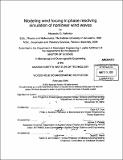| dc.contributor.advisor | Dick K.P. Yue. | en_US |
| dc.contributor.author | Kalmikov, Alexander G | en_US |
| dc.contributor.other | Woods Hole Oceanographic Institution. | en_US |
| dc.date.accessioned | 2010-08-31T14:44:21Z | |
| dc.date.available | 2010-08-31T14:44:21Z | |
| dc.date.copyright | 2010 | en_US |
| dc.date.issued | 2010 | en_US |
| dc.identifier.uri | http://hdl.handle.net/1721.1/57791 | |
| dc.description | Thesis (S.M.)--Joint Program in Oceanography/Applied Ocean Science and Engineering (Massachusetts Institute of Technology, Dept. of Mechanical Engineering; and the Woods Hole Oceanographic Institution), 2010. | en_US |
| dc.description | Cataloged from PDF version of thesis. | en_US |
| dc.description | Includes bibliographical references (p. 148-152). | en_US |
| dc.description.abstract | Wind waves in the ocean are a product of complex interaction of turbulent air flow with gravity driven water surface. The coupling is strong and the waves are non-stationary, irregular and highly nonlinear, which restricts the ability of traditional phase averaged models to simulate their complex dynamics. We develop a novel phase resolving model for direct simulation of nonlinear broadband wind waves based on the High Order Spectral (HOS) method (Dommermuth and Yue 1987). The original HOS method, which is a nonlinear pseudo-spectral numerical technique for phase resolving simulation of free regular waves, is extended to simulation of wind forced irregular broadband wave fields. Wind forcing is modeled phenomenologically in a linearized framework of weakly interacting spectral components of the wave field. The mechanism of wind forcing is assumed to be primarily form drag acting on the surface through wave-induced distribution of normal stress. The mechanism is parameterized in terms of wave age and its magnitude is adjusted by the observed growth rates. Linear formulation of the forcing is adopted and applied directly to the nonlinear evolution equations. Development of realistic nonlinear wind wave simulation with HOS method required its extension to broadband irregular wave fields. Another challenge was application of the conservative HOS technique to the intermittent non-conservative dynamics of wind waves. These challenges encountered the fundamental limitations of the original method. Apparent deterioration of wind forced simulations and their inevitable crash raised concerns regarding the validity of the proposed modeling approach. The major question involved application of the original HOS low-pass filtering technique to account for the effect of wave breaking. It was found that growing wind waves break more frequently and violently than free waves. | en_US |
| dc.description.abstract | (cont.) Stronger filtering was required for stabilization of wind wave simulations for duration on the time scale of observed ocean evolution. Successful simulations were produced only after significant sacrifice of resolution bandwidth. Despite the difficulties our modeling approach appears to suffice for reproduction of the essential physics of nonlinear wind waves. Phase resolving simulations are shown to capture both - the characteristic irregularity and the observed similarity that emerges from the chaotic motions. Energy growth and frequency downshift satisfy duration limited evolution parameterizations and asymptote Toba similarity law. Our simulations resolve the detailed kinematics and the nonlinear energetics of swell, windsea and their fast transition under wind forcing. We explain the difference between measurements of initial growth driven by a linear instability mechanism and the balanced nonlinear growth. The simulations validate Toba hypothesis of wind-wave nonlinear quasi-equilibrium and confirm its function as a universal bound on combined windsea and swell evolution under steady wind. | en_US |
| dc.description.statementofresponsibility | by Alexander G. Kalmikov. | en_US |
| dc.format.extent | 152 p. | en_US |
| dc.language.iso | eng | en_US |
| dc.publisher | Massachusetts Institute of Technology | en_US |
| dc.rights | M.I.T. theses are protected by
copyright. They may be viewed from this source for any purpose, but
reproduction or distribution in any format is prohibited without written
permission. See provided URL for inquiries about permission. | en_US |
| dc.rights.uri | http://dspace.mit.edu/handle/1721.1/7582 | en_US |
| dc.subject | Joint Program in Oceanography/Applied Ocean Science and Engineering. | en_US |
| dc.subject | Mechanical Engineering. | en_US |
| dc.subject | Woods Hole Oceanographic Institution. | en_US |
| dc.subject.lcsh | Ocean-atmosphere interaction | en_US |
| dc.subject.lcsh | Ocean waves | en_US |
| dc.title | Modeling wind forcing in phase resolving simulation of nonlinear wind waves | en_US |
| dc.type | Thesis | en_US |
| dc.description.degree | S.M. | en_US |
| dc.contributor.department | Joint Program in Oceanography/Applied Ocean Science and Engineering | en_US |
| dc.contributor.department | Woods Hole Oceanographic Institution | en_US |
| dc.contributor.department | Massachusetts Institute of Technology. Department of Mechanical Engineering | |
| dc.identifier.oclc | 650279462 | en_US |

